 For quite a few years, NASCAR has had internet subscription models for watching and listening to the races. But now, for the first time, NASCAR surprised me by offering all of the remaining races this season for free on YouTube (after the race is over.) That’s an especially cool deal for me since some of these races are on ESPN which I don’t pay for anymore. You can check out the New Hampshire race from last week. It’s exciting to see more and more sports embracing the Internet.
For quite a few years, NASCAR has had internet subscription models for watching and listening to the races. But now, for the first time, NASCAR surprised me by offering all of the remaining races this season for free on YouTube (after the race is over.) That’s an especially cool deal for me since some of these races are on ESPN which I don’t pay for anymore. You can check out the New Hampshire race from last week. It’s exciting to see more and more sports embracing the Internet.
Ride Along
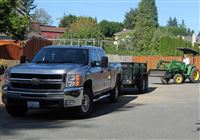 I’m continually amazed by people merging in front of big trucks and semis, especially as traffic is coming to a stop. I see it every day. Why do you think the truck is leaving that space? It’s so they don’t kill the people in front of them. I wonder if it would help to add a “big rig ride along” day as part of driver’s ed. Students would go ride with a professional driver for an hour or so. Drivers would learn a lot about how long it takes to stop a truck and what cars do that is dangerous around trucks. There are likely a lot of legal and liability issues with that idea, but if implemented correctly, it might improve our overall safety.
I’m continually amazed by people merging in front of big trucks and semis, especially as traffic is coming to a stop. I see it every day. Why do you think the truck is leaving that space? It’s so they don’t kill the people in front of them. I wonder if it would help to add a “big rig ride along” day as part of driver’s ed. Students would go ride with a professional driver for an hour or so. Drivers would learn a lot about how long it takes to stop a truck and what cars do that is dangerous around trucks. There are likely a lot of legal and liability issues with that idea, but if implemented correctly, it might improve our overall safety.
I thought a lot about this last weekend while driving around a 5300lb truck pulling 10,000 pounds of trailer and dirt. It’s the truck driver’s responsibility to be safe, but just in the short time I was driving that rig, there were at least a couple people who were saved from a messy death only because I guessed ahead of time that they were going to do something stupid.
Fantasy Football – Week 3
The rematch of last year’s Super Bowl proved to be quite a bit more exciting and suspenseful than the Super Bowl itself. Peyton Manning drove the Broncos down the field for a touch down and two point conversion to tie up the game with seconds remaining, but then Russell Wilson matched him and led the Seahawks to a game winning OT TD. Oh and by the way, Peyton Manning is making more than 22 times as much money as Russell Wilson this year.
In our league, all of the games except one ended on Sunday without needing Monday Night Football to finish them off. Logan and Andy broke their losing streaks, and Tim defeated Luke to be the only remaining undefeated team.
Bye weeks start this week! Combined with all the injuries to big names in the league this week, please pay close attention to your roster to avoid 0’s.
Now on to the weekly awards.
- Highest Team Score
- This Week: Ben had 129.50
- Season: In Week 1, Ben had 137.85
- All-Time: In 2013, Tim had 195.50
- Lowest Team Score
- This Week: Luke had 55.04
- Season: The previous record was in Week 1, Jim had 82.00
- All-Time: In 2011, Luke had 47.01
- Biggest Blowout
- This Week: Tim beat Luke by 64.34
- Season: The previous record was in Week 2, Jim beat Dad by 49.04
- All-Time: In 2010, Luke beat Andy by 113.02
- Closest Win
- This Week: Andy beat Dad by 7.82.
- Season: In Week 2, Austin beat Ben by 1.7
- All-Time: In 2012, Jim beat Ben by 0.12
- Highest Scoring Player
- This Week: Andrew Luck had 40.30 for Ben
- Season: The previous record was in Week 1, Matt Ryan scored 37.42 for Dad
- All-Time: In 2013, Peyton Manning scored 60.28 for Andy
- Longest Winning Streaks:
- Active: Tim has a 3 game winning streak
- Season: Tim has a 3 game winning streak
- All-Time: In 2011, Micah had an 8 game winning streak
- Longest Losing Streaks:
- Active: Dad has 2 game losing streak
- Season: Dad, Logan and Andy had 2 game losing streaks
- All-Time: In 2011, Kyle had a 14 game losing streak
While Peyton played a pretty good game, he did give us some good “Manning Faces” to choose from. This one was near the end of the game after Kam Chancellor intercepted him and ran it back 52 yards to the Denver 35.
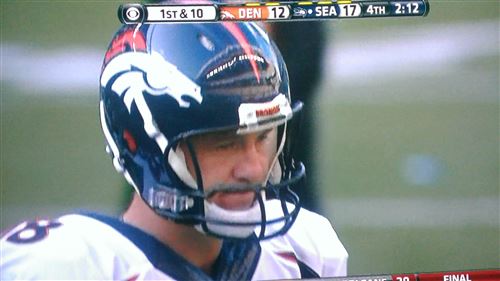
Evergreen Speedway
For Father’s Day of 2013, Tyla and I got Don a night at the track up in Monroe. We’ve all talked about seeing a race there so it seemed like a good gift idea. It was, but it took us over a year to actually get up there! It was a fun night though. We saw a bunch of smaller races and then the late model cars took to the bigger outside oval for their 100 lap race. I could definitely see going back and it will be fun to take Elijah there once he’s a little older. Tickets were under $20 so it’s a pretty good deal.
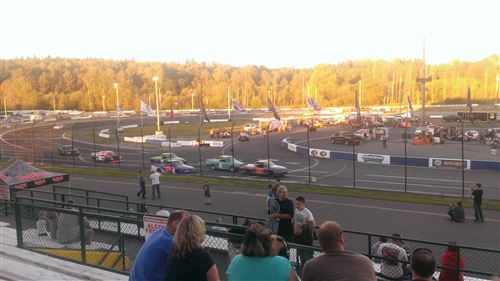
Outlets
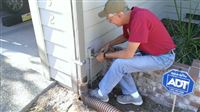 You can never have too many outlets in your shop. I finally got fed up with running extension cords all over the place so while Dad was visiting, we got our electrician on. Three new outlets were added inside: one near the bottom of my shelves to power the air compressor and the battery tender for the motorcycle, one by the irrigation clock, one up in the rafters by the IR light and the security camera. We also added two more outside that are on the same timer circuit as my outdoor lights: one is near the ground and one is up under the eaves. Why do that? For Christmas lights of course! I’ll have easy places to plug them in and then I’ll be able to control them with our fancy timer switch from inside the house. Thanks for the help Dad!
You can never have too many outlets in your shop. I finally got fed up with running extension cords all over the place so while Dad was visiting, we got our electrician on. Three new outlets were added inside: one near the bottom of my shelves to power the air compressor and the battery tender for the motorcycle, one by the irrigation clock, one up in the rafters by the IR light and the security camera. We also added two more outside that are on the same timer circuit as my outdoor lights: one is near the ground and one is up under the eaves. Why do that? For Christmas lights of course! I’ll have easy places to plug them in and then I’ll be able to control them with our fancy timer switch from inside the house. Thanks for the help Dad!
Birthday Food Extravaganza
When Tyla asked what I wanted to eat for my birthday dinner, I said “BACON LOG!” It’s been a long time since we’ve made one and sitting outside in the sunshine by a smoker for a few hours seemed like a good way to spend the day. Don got in on the action too and decided to smoke a brisket. He really went all out marinating it for two days and then starting the smoker at midnight. He got up every couple hours to check on it. He also chopped up two grill baskets full of veggies. Thanks Don! While we had all that going, we also cooked up a new batch of hot sauce. This time we did it with all mango instead of including some papaya. Logan dubbed this one “Yellow Fever.” It came out delicious though Logan claims the Agent Orange recipe is better.
There was so much delicious food that day. Thank you to everyone for helping to put it together and for letting me fulfill my dream of making another bacon long!
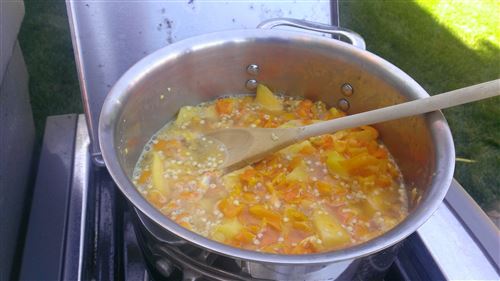
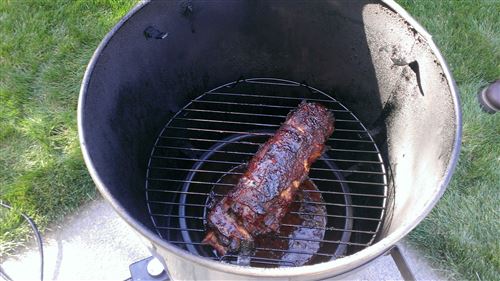
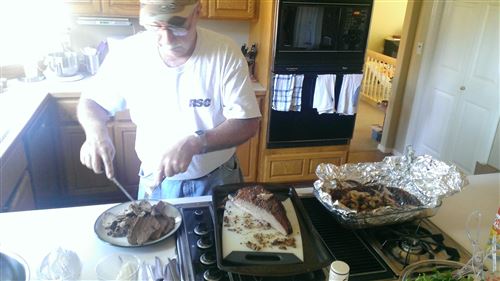
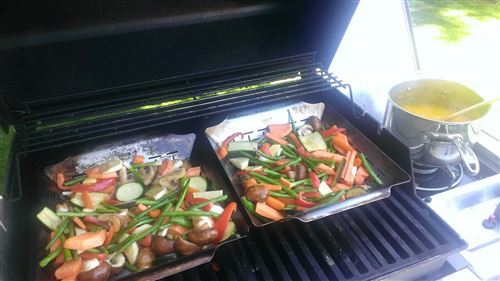
Bixler 2
 After about a year of flying cheapo RC planes made out of foam board from the dollar store, I feel like I’m ready to attempt my first “real” RC plane. A huge thanks goes to Tyla for buying me the Bixler 2 that I’ve had my eye on. It’s still a beginner plane, but it’s much more capable than what I’ve been flying. Plus, there is a big community built up around this plane of people who make modifications for flying FPV (First Person View) and other things like that. I’m looking forward to putting it together and tossing it in the air. Any bets about how long it will fly before it’s first crash?
After about a year of flying cheapo RC planes made out of foam board from the dollar store, I feel like I’m ready to attempt my first “real” RC plane. A huge thanks goes to Tyla for buying me the Bixler 2 that I’ve had my eye on. It’s still a beginner plane, but it’s much more capable than what I’ve been flying. Plus, there is a big community built up around this plane of people who make modifications for flying FPV (First Person View) and other things like that. I’m looking forward to putting it together and tossing it in the air. Any bets about how long it will fly before it’s first crash?
Fantasy Football – Week 2
Ouch. Tough game for the Seahawks. It stands to reason that they weren’t going to run through the season undefeated but I wouldn’t have guessed that San Diego would have taken them out. San Diego played a pretty solid game though aside from some poorly timed penalties. Hopefully Pete Carroll can turn this around and use it to encourage the team.
In our league, two of the four undefeated teams lost leaving the Scherschel brothers to fight it out for first place. Luke currently holds the first spot with the tiebreaker of points but Tim is close behind. There are four teams with one win and then Logan and Andy are still looking for their first win.
Guys, we had a LOT of 0’s on the board this week. There were so many that I didn’t even take the time to see which ones should have been preventable. Get your rosters up to date with respect to injuries, and remember that bye weeks start in week 4.
Now on to the weekly awards. This week I added winning and losing streaks to the list. I don’t have prior history for this one so we’ll just keep track from this season forward.
- Highest Team Score
- This Week: Jim had 137.41
- Season: In Week 1, Ben had 137.85
- All-Time: In 2013, Tim had 195.50
- Lowest Team Score
- This Week: Dad had 88.37
- Season: In Week 1, Jim had 82.00
- All-Time: In 2011, Jim beat Luke by 83.79
- Biggest Blowout
- This Week: Jim beat Dad by 49.04
- Season: Previous record was in Week 1, Luke beat Jim by 41.27
- All-Time: In 2010, Luke beat Andy by 113.02
- Closest Win
- This Week: Austin beat me by 1.7
- Season: Previous record was in Week 1, Dad beat Austin by 27.16
- All-Time: In 2012, Jim beat me by 0.12
- Highest Scoring Player
- This Week: Aaron Rodgers had 34.64 for Tim.
- Season: In Week 1, Matt Ryan scored 37.42 for Dad
- All-Time: In 2013, Peyton Manning scored 60.28 for Andy
- Longest Winning Streaks:
- Active: Tim and Luke have 2 game winning streaks
- Season: Tim and Luke have 2 game winning streaks
- Longest Losing Streaks:
- Active: Logan and Andy have 2 game losing streaks.
- Season: Logan and Andy have 2 game losing streaks.
There’s no shot of the opposing QB feeling dejected after playing the Seahawks this week. The Seattle D did not live up to their reputation this week.
Front Yard Plan
My neighbors have had to look at quite a mess for the past couple months. The back yard is beautiful but all we did in the front yard was tear out all the plants and leave 4-5 yards of dirt piled up in the side yard. We took a break from that project to give Tim time to put new siding on his house. The siding is done so it’s back to the yard project!
The front yard should go much quicker than the back yard did because we’re doing a lot less work. Here’s what is on the agenda:
- Scrape off all the sod and the top ~6” of dirt
- Bring in new dirt
- Add downspout drains out to the street
- Extend the back yard irrigation system into the front yard.
- Install new sod
If all goes according to plan, we’ll be done in two weeks. I can hear you laughing now. When’s the last time Tim and I worked on a project together and had it go “according to plan”?

I-405 Project
I had thought that after the change, we wouldn’t be able to get onto 522 from 160th St anymore but it looks like they have accounted for that in the design. That’s great for us because it means we’ll be able to head out that way without driving through the traffic mess in Woodinville.
The people who bought those townhomes right along the new braided exit ramps are going to be treated to an enormous sound blocking wall right outside their balconies. They’re going from having a view that had about 3 or 4 rows of trees between them and 405 to seeing a concrete wall 10-20 feet away. Ouch. At least the real estate market is starting to recover around here so some of the decrease will be masked.
And since I mentioned real estate, here’s a semi-related factoid: the guy who bought our condo from us sold it a few months ago. He sold it for about 20% more than he bought it so he made a little money after all the fees and taxes. Our house has gone up about 3-4 times as much as that condo did though so I still think it was a good financial move. (And it was a great move for many other reasons.)